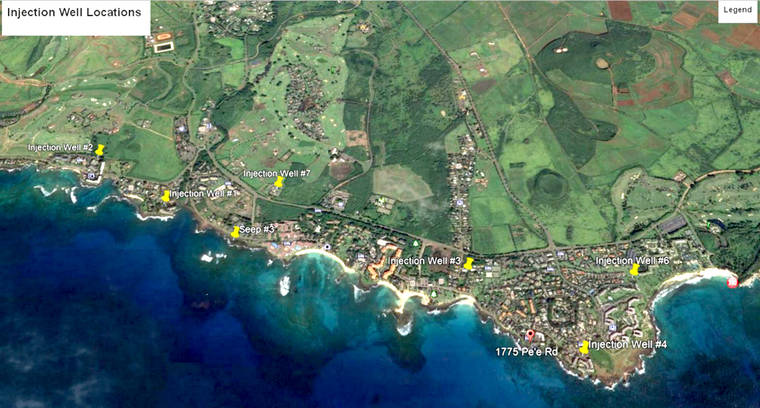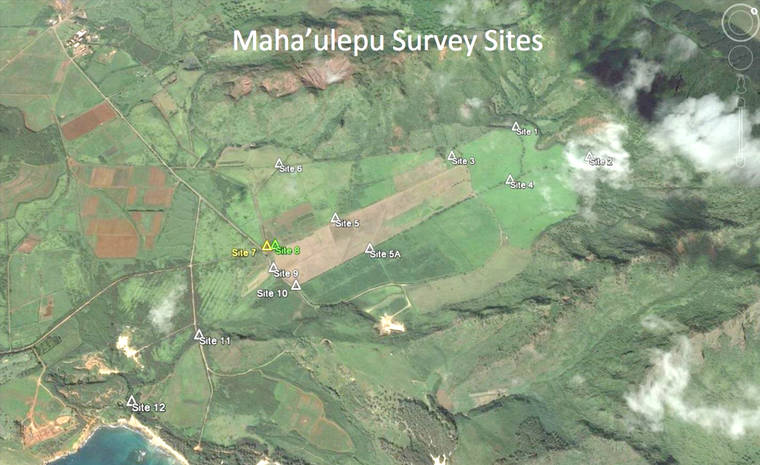LIHUE The Department of Health is making a trip to Kauai to explain their recent findings regarding the water quality in the Mahaulepu and Waikomo watersheds.
LIHUE — The Department of Health is making a trip to Kauai to explain their recent findings regarding the water quality in the Maha‘ulepu and Waikomo watersheds.
The meeting is scheduled 4 to 6 p.m. July 24 at the Kauai District Health Office. It is targeted at explaining how DOH determined that human waste is not the cause of bacterial contamination in the water tested as part of a study on water quality in the area.
That study was released in June and said the water was safe for swimming.
PhyloChip testing was used to track the source of high bacteria counts in places like the Waiopili Stream and along the shorelines in the Maha‘ulepu and Waikomo watersheds.
Scientists with The Berkeley Lab were contracted by DOH to lead the survey effort. Several conclusions were drawn, including the high concentrations of fecal indicating bacteria in the Waiopili Ditch and Waikomo Streams were not caused by human or animal fecal contamination.
Researchers did detect weak human signals in some samples from those streams, and in a coastal seep along the beachfront of the Poipu resort area. The strength of the human signal was comparable in magnitude and microbial composition to injection wells in Poipu, according to the study.
Some folks on Kauai, however, disagree — namely scientists with Surfrider Kauai’s Blue Water Task Force and members of Friends of Maha‘ulepu, a citizen-group fighting for clean water and community access in the watershed.
Their concerns are twofold: that DOH is being too bold in saying the water is safe for swimming and that the study itself isn’t as accurate as DOH says.
“The HDOH claims that the water in Maha‘ulepu is safe for human exposure despite inconsistent and conflicting data generated by the study and presented in the report,” says Surfrider’s John Alderete.
Representatives from DOH Clean Water Branch will be at the July 24 meeting. Also available by video conference will be one of the study’s principal investigators, Dr. Eric Dubinsky, from the Lawrence Berkeley National Laboratory.





Are there anybody swimming in the area now? Surfers.
You can have any type of “evidence” so long as those envelopes are stuffed full of benjamines. Who knows maybe those that sit on this “research” group are either family members or close friends of the State, so they know, they’ll “massage” the results so that that study look favorable for Grove Farm where there are those with Japanese surnames who benefit at your expense.
After all, Kauai’s DNLR is the most corrupt in the State.
Could it have been part of a scam to keep the Dairy out?
Lumahai Mike, nope.
It amazes me that no one reads the actual report. If you did you would see that the same phylochip that found no human fecal bacteria in the Waiopili stream also found no fecal bacteria in the cesspool that definitely contained fecal matter. How is that you ask. I would suggest to you that the phylochip reader was malfunctioning or calibrated incorrectly. The entire report is useless when the equipment used is malfunctioning. In the very last paragraph the authors/Berkeley Labs says more tests are needed ( because of false negatives ie. No fecal bacteria in a fecal laden cesspool).
If the Department of Health thinks for one second that it is OK for us to swim in the Waiopili or other contaminated areas then they should prove it to us by letting us all watch as they swim in the cesspool that tested negative for human fecal bacteria. Arryl Kaneshiro should bring a picture of himself and his baby swimming, sitting and playing in the Waiopili then I will join them after the incubation period is over and they are not violently ill with ecoli and staphylococcal infection. Until then I’m sorry I’m just not that gullible or stupid to swim in these bacteria ridden areas.
I also, notice there was no mention of nor testing of the site by CJM Ranch at Maha’ulepu on Grove Farm property, where the Department of Health permitted four companies to dump human sewage for ten years. My question to you Is this whole study to cover up DOH’s culpability?
A Freedom of Information release of emails from the HDOH show that the PhyloChip study was “baffling and disturbing” since the lab tested cesspools where human source caused the fecal bacteria and the PhyloChip was unable to confirm that the fecal bacteria it was testing was from humans. HDOH persuaded the lab to change the report and it’s conclusion that the data showed clear evidence of “false negatives”. There certainly seems to show manipulation of the data by HDOH. It seems to be a dereliction of duty for Department of Health officials, whose job it is to protect public health, to intervene and manipulate data to put public health at risk.